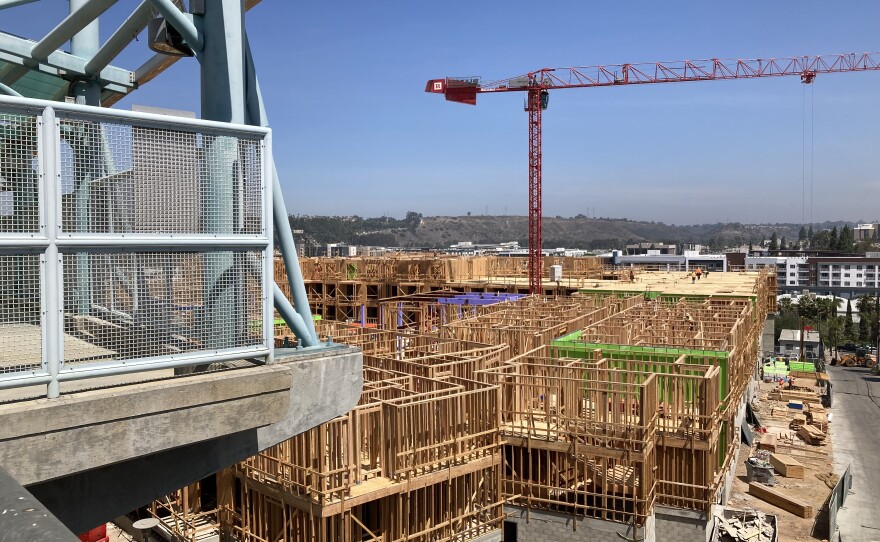In North Park, Jake Hueras has an apartment that costs $2,100 a month. It’s a one bedroom, one bath, and 650 square-foot place that he shares with his girlfriend. He’s boosted the debt on his credit card and he’s canceled his health insurance to help make ends meet. He was forced out of another apartment in Normal Heights and his new place is smaller and more expensive.
“About a hundred dollars more,” Hueras said. “We lost a bedroom and a bathroom. A hundred square feet. But it was the only place that had the criteria we needed.”
The cost of homes in San Diego is the highest it has ever been. A survey by the Texas home-buying website OJO Labs has called San Diego the least affordable metro area in the U.S. And people like Hueras are seeing it firsthand.
His story is typical in a San Diego market where rents have increased 19% over the past year, according to the apartment listing website Apartment List. In 2020, some markets, like San Francisco, saw rents decrease with the pandemic. In San Diego, they just kept rising.
Jan Neff-Sinclair rents an apartment for $2,800 dollars a month in Carlsbad. Like Hueras, she was recently forced out of another apartment when the building was sold. She can pay for her new place on her disability income, thanks to her roommate's Section 8 voucher. But it’s hard for her to know how long that’ll last.
“It’s affordable now,” Neff-Sinclair said. “If they raise the rent again in October, it probably won’t be, unless social security goes up a lot — or the housing voucher goes up a lot.”
As rents surge upward, mortgages are doing the same. The San Diego Association of Realtors reports the median sales price for a detached, single-family home in San Diego was $1 million in April. Just like the rental market, that’s up 19% from a year before.
Political pressures and a dwindling supply of buildable land have long prevented San Diego from keeping up with the demand for new housing, according to Alan Gin, an economics professor at the University of San Diego.
Today’s rising home prices are fueling speculation, he said, as investors make cash offers for homes in hopes of selling them for a profit. And something else happened over the course of the COVID-19 pandemic — Gin calls it the pandemic piggy bank.
“During the pandemic, a lot of people were able to keep working. They were still drawing in a lot of income, but they didn’t have anywhere to spend it,” Gin said. “So people built up a reserve of cash. Once the pandemic ended, or once things started opening up again, people took that money and started to spend it in the economy, and one place they put that money was into the housing market.”
Million-dollar houses in San Diego
Who can afford a million-dollar home? San Diego realtor Stephanie Lloyd said a lot of her dual-income clients just don’t have the money that’s required.
“If you’re buying a million-dollar home, typically what I’m seeing is income, either singular or combined, probably around $200,000. And with a 20% down payment to go with that,” said Lloyd.
The pandemic is the source of much of the increase in home prices, and Lloyd said it’s not just pent-up demand and the “pandemic piggy bank.”
She said the trend toward remote work has changed the way people view their homes. It’s no longer a place you leave half the time when you’re going to work or shopping, a lot of which is done online.

“So (the home) is no longer just the place where they rest and recover but it’s also their office. It’s also the space where they eat all of their meals and spend a lot of their leisure time,” she said. “Right now what people want is the full experience of comfort, space, views … recreation areas. Backyards have become more important than ever.”
The level of San Diego’s affordability crisis may be unique, but it is part of a national trend. Apartment List reports that rents increased 16% nationwide in the past 12 months. That’s just three percentage points less than in San Diego.
For the region’s housing dilemma, shrinking demand doesn’t seem to be in the cards.
“San Diego is a sticky market,” said Chris Salviati, an economist with Apartment List.
That means that despite high home prices, people still don’t want to leave and lots of people are trying to move here.
“The folks that are searching for apartments in San Diego, about 40% of them are searching from outside the metro,” said Salviati. “So the flow of folks coming from outside the metro (is) kind of out-weighing the folks who want to leave the metro.”
Politicians and developers look for answers
If demand remains high, is there some way to address San Diego’s housing shortage?
Marco Li Mandri believes there is. He's president of New City America, which specializes in creating urban development districts. In San Diego, he is best known for the revitalization of Little Italy. Li Mandri doesn’t accept the idea that San Diego has run out of buildable land. It’s got plenty of land, Li Mandri said. You just have to knock down the obsolete buildings that are sitting on it.
“I think what we did is we overbuilt in the United States in the 20th Century,” Li Mandri said, as we spoke in San Diego’s Kensington neighborhood. He added the result of that overbuild today is lots of retail and office buildings that have lost their value and can make way for housing.
“We’re here on Adams Avenue. We’re looking up and down, you see a lot of one-story non-historic buildings," he said. "And the example I’ll give you is the old Demille’s restaurant that was there for years. For decades. On a 15,000-square-foot lot, if I’m not mistaken. They just sold that. And there are going to be more than 100 apartments built there.”
Li Mandri said if the housing market is going to meet the demand, those kinds of projects need to move ahead — and developers will need to build up. That means dense, multi-story housing is going to be in San Diego’s future, and we had better get used to it.
It is happening in many parts of San Diego. In Grantville, developers are building a 126-unit affordable apartment complex right next to a trolley stop.
The city of San Diego’s Complete Communities program is allowing greater height and greater density in new developments that provide affordable housing and are near public transit.
More affordable housing may take shape in San Diego's future. For now, people like Hueras, who works in construction, are doing their best to navigate the challenges of today's housing market.
Hueras said he’s worked on remodels of people’s homes, and he wonders where they find the money.
“You know people who have plenty of money to do these remodels and stuff and I feel like I’m just a hard-working guy. I feel like I have an uncanny work ethic and here I am, pushing 50 hours a week, and I can barely scrape by,” Hueras said.
Higher interest rates may lead to a cooling housing market, but just scraping will likely remain a reality for a lot of people into the foreseeable future.
-
San Diego housing prices are the highest they have ever been. How did we get to now? And how do we cope?
-
An ex-caregiver and convicted sex offender pleaded guilty Tuesday to sexually assaulting two women in San Diego area nursing homes.









